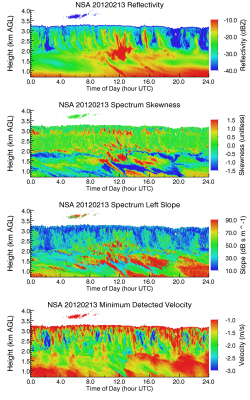
Since 2004, the ARM Climate Research Facility has collected continuous recordings of profiling radar Doppler spectra. These recorded spectra offer a powerful means for overcoming the dependency of radar measurements on particle size (proportional to the sixth power of particle diameter), thus enabling the identification of both small and large particle populations in a radar sampling volume. This advances the ability to study and understand the microphysical and dynamical processes underlying the production and evolution of hydrometeors in clouds and precipitation.
While direct observations of radar Doppler spectra sometimes hold the key to new insight, it is often more useful to work with spectra indirectly through their extended moments, e.g., skewness and kurtosis, and other parameters that compactly capture the shape and complexity of their information. This is the purpose of the new value-added product (VAP) Micro-Active Remote Sensing of Clouds (MICROARSCL) currently under evaluation. This new VAP has a familiar name—Active Remote Sensing of Clouds—but with a host of new complementary parameters and data release that offers a mix of one year of data from the Tropical Western Pacific site and five years of data encompassing three ARM field campaigns:
- Midlatitude Continental Convective Clouds Experiment (MC3E) at the Southern Great Plains (SGP) site
- Routine AAF Clouds with Low Optical Water Depths (CLOWD) Optical Radiative Observations (RACORO), also at SGP
- Clouds, Aerosol and Precipitation in the Marine Boundary Layer (CAP-MBL) ARM Mobile Facility deployment in the Azores.
The released version of MICROARSCL contains about 30 parameters. A growing body of peer-reviewed research has linked some of those parameters—available for the first time in an ARM product—to microphysical processes in liquid and ice clouds. These parameters can also serve as an information-rich neutral interface for comparison in fine detail of high-resolution large-eddy simulation model output with representative observations through radar Doppler spectra forward simulations. As an example, one recently released simulator, the McGill Radar Doppler Spectra Simulator (MRDSS), is available here.
In order to facilitate the analysis and application of radar Doppler spectra in cloud research, a new toolkit was also developed. The Brookhaven National Laboratory Doppler Radar Spectra Visualization and Analysis Java Toolkit offers an efficient and powerful means to dynamically explore spectra and their MICROARSCL parameters in great detail, relate spectra observed by different collocated radars to each other, and analyze all of this information in the context of a suite of additional measurements from collocated lidars, microwave radiometers, soundings, and radiation sensors. To learn more about the visualization toolkit, read this Atmospheric System Research announcement.
Feedback and use of the data are welcomed and encouraged; for questions, or to report data problems, please contact Mike Jensen or Ed Luke. These data sets can be accessed through the ARM Data Discovery.

